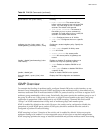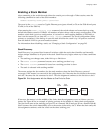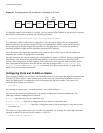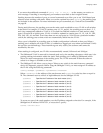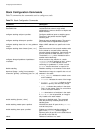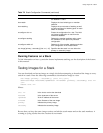
Configuring a Stack
Summit 200 Series Switch Installation and User Guide 241
If you enter the traditional command of config vlan v1 add po * on the master you receive an
error message. If stacking is unconfigured, port numbers resort back to their original format.
Stacking increases the number of ports, so several commands now allow you to use VLAN-based port
selection when working with stacks. When you use the optional keyword,
stacking, the stacking ports
are included in the selection. For more information on port commands, see “Switch Port Commands”
on page 89.
During stack discovery, the stacking ports on the entire stack are added to every VLAN on all switches
in the stack. For example, if VLAN A contains ports 1:1, 2:1, and 4:1, the stacking ports on slots 1, 2, 3,
and 4 are automatically added to VLAN A. If you had four 200S-48 switches in a stack and are using
ports 1:50 and 4:50 as uplink ports, VLAN A would be updated to contain ports 1:1, 1:2, 1:49, 2:1, 2:49,
2:50, 3:49, 3:50, 4:1, and 4:49. Even when there are no user ports in a VLAN from a particular member
switch, the stacking ports on that switch are automatically added into the VLAN.
After a port is identified as a stacking port no further configuration is allowed on that port. When a
stacking port is added to all of the VLANs, it is added as a tagged port even when user-defined VLANs
do not have user-defined tags. These internal tags are only used by the software and cannot be
modified by the user.
After stacking is configured, two VLANs are automatically created, StkInternal and StkMgmt.
• The StkInternal VLAN is reserved for internal stack use by the stacking subsystem, which uses it for
passing stacking information within the stack. Each stacking port is added to StkInternal which
allows for easier management of the stacking ports. The VLAN name and ID that the software
selects is no longer is available to the user.
• The StkMgmt VLAN allows you to ping or Telnet to any switch in the stack from any connected
device for diagnostic purposes. Before using the StkMgmt VLAN, you must assign an IP address to
the VLAN using the following command:
config StkMgmt ipaddress <ipaddress>/<netmask>
Where <ipaddress> is the address of the stack master and netmask is a value less than or equal to
29. The command reserves a block of eight addresses for the StkMgmt VLAN:
To access any one of the stack members, use the IP address assigned to that slot. For example, if the
StkMgmt has IP address 192.207.35.1, to access slot 5 specify:
telnet 192.207.35.5
ipaddress Specifies the IP address of the stack master (slot 1)
ipaddress + 1 Specifies the IP address of stack member 2 (slot 2)
ipaddress + 2 Specifies the IP address of stack member 3 (slot 3)
ipaddress + 3 Specifies the IP address of stack member 4 (slot 4)
ipaddress + 4 Specifies the IP address of stack member 5 (slot 5)
ipaddress + 5 Specifies the IP address of stack member 6 (slot 6)
ipaddress + 6 Specifies the IP address of stack member 7 (slot 7)
ipaddress + 7 Specifies the IP address of stack member 8 (slot 8)



